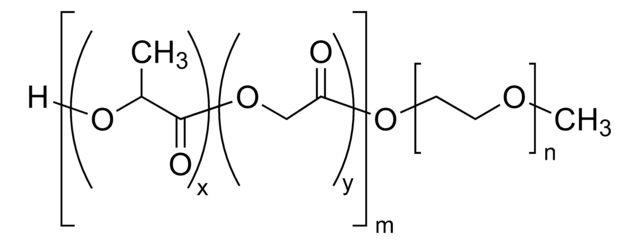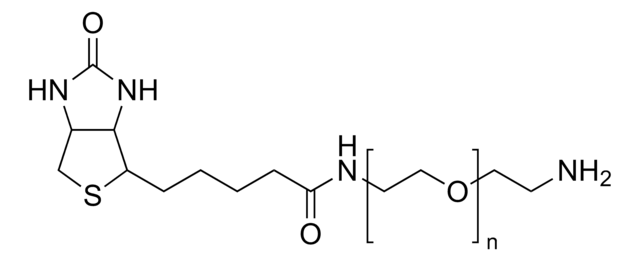909882
Biotin-poly(ethylene glycol)-b-poly(lactide-co-glycolide)
PEG average Mn 2,000, PLGA average Mn 10,000, lactide:glycolide 50:50
Sinônimo(s):
Biotin-PEG-PLGA
Faça loginpara ver os preços organizacionais e de contrato
About This Item
Fórmula linear:
H[(C3H4O2)x(C2H2O2)y]mO[C2H4O]nC16H25N6SO5
Código UNSPSC:
51171641
NACRES:
NA.25
Produtos recomendados
Formulário
powder or chunks
proporção de alimentação
lactide:glycolide 50:50
peso molecular
PEG average Mn 2,000 (by NMR)
PLGA average Mn 10,000 (by NMR)
cor
white to tan
temperatura de armazenamento
−20°C
Aplicação
Biotin-poly(ethylene glycol)-b-poly(lactide-co-glycolide) is a functionalized, amphiphilic, diblock copolymer composed of a hydrophilic PEG block and a hydrophobic PLGA block. These biodegradable, biocompatible polymers can self-assemble to form nanoparticles, such as micelles and polymersomes, in both aqueous and non-aqueous media. Due to these properties, these polymers are widely used in polymeric nanoparticle formulation to achieve controlled and targeted delivery of therapeutic agents (e.g. APIs, genetic material, peptides, vaccines, and antibiotics). The biotin functional group on the PEG chain enables rapid and facile surface functionalization, allowing for these materials to be used in applications such as targeted drug delivery.
Código de classe de armazenamento
11 - Combustible Solids
Classe de risco de água (WGK)
WGK 3
Ponto de fulgor (°F)
Not applicable
Ponto de fulgor (°C)
Not applicable
Escolha uma das versões mais recentes:
Certificados de análise (COA)
Lot/Batch Number
Não está vendo a versão correta?
Se precisar de uma versão específica, você pode procurar um certificado específico pelo número do lote ou da remessa.
Já possui este produto?
Encontre a documentação dos produtos que você adquiriu recentemente na biblioteca de documentos.
Miles A Miller et al.
Nature communications, 6, 8692-8692 (2015-10-28)
Therapeutic nanoparticles (TNPs) aim to deliver drugs more safely and effectively to cancers, yet clinical results have been unpredictable owing to limited in vivo understanding. Here we use single-cell imaging of intratumoral TNP pharmacokinetics and pharmacodynamics to better comprehend their
Jijin Gu et al.
Molecular pharmaceutics, 12(8), 2889-2903 (2015-06-24)
The goal of this study was to develop and characterize a novel intravaginal film platform for targeted delivery of small interfering RNA (siRNA)-loaded nanoparticles (NP) to dendritic cells as a potential gene therapy for the prevention of sexually transmitted human
Soroush Ardekani et al.
Scientific reports, 5, 16258-16258 (2015-11-21)
Nitroglycerin (NTG) markedly enhances nitric oxide (NO) bioavailability. However, its ability to mimic the anti-inflammatory properties of NO remains unknown. Here, we examined whether NTG can suppress endothelial cell (EC) activation during inflammation and developed NTG nanoformulation to simultaneously amplify
Nossa equipe de cientistas tem experiência em todas as áreas de pesquisa, incluindo Life Sciences, ciência de materiais, síntese química, cromatografia, química analítica e muitas outras.
Entre em contato com a assistência técnica







